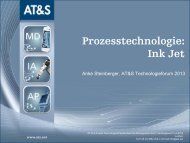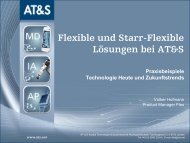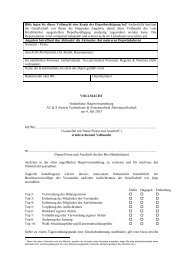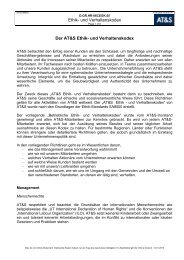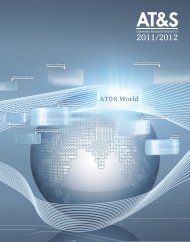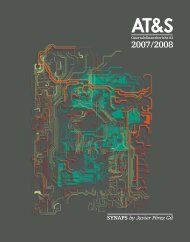AT&S World
AT&S World
AT&S World
Create successful ePaper yourself
Turn your PDF publications into a flip-book with our unique Google optimized e-Paper software.
At the time of acquisition they are stated at cost, including transaction<br />
costs, in subsequent periods at their respective fair values.<br />
Unrealised profits and losses, net of tax, are recognised in<br />
equity and not taken through profit or loss until they are sold or<br />
considered as impaired.<br />
Interest income and dividends from securities available for sale<br />
are included in the income statement under “Financial result”.<br />
When a security available for sale is sold, the accumulated unrealised<br />
profit or loss recognised in equity is included in “Financial<br />
result” in the reporting period.<br />
When a security available for sale is considered impaired, the accumulated<br />
unrealised loss recognised in equity is charged to the<br />
income statement under “Financial result”. An asset is impaired,<br />
if there are indications that the fair value is below its carrying<br />
amount. In particular, this is the case, if the decrease in fair<br />
value is of such extent that the acquisition cost is unlikely to be<br />
recovered in the foreseeable future. Recoverability is reviewed<br />
annually at the balance sheet date.<br />
Furthermore, those financial assets are recognised under available-for-sale<br />
financial assets that have not been allocated to any<br />
of the other categories described. If the current fair value for<br />
listed equity instruments cannot be determined reliably, these<br />
financial assets will be measured at cost. Impairment losses, if<br />
any, are recognised in the income statement, and the respective<br />
impairment losses shall not be reversed.<br />
l. Derivative financial instruments<br />
The Group enters into derivative financial instruments to hedge<br />
against foreign currency fluctuations related to transactions in<br />
foreign currencies – in particular the US dollar. These instruments<br />
mainly include forward contracts, foreign currency options<br />
and foreign exchange swap contracts and are entered into<br />
in order to protect the Group against exchange rate fluctuations<br />
– by fixing future exchange rates for foreign currency assets<br />
and liabilities.<br />
Consolidated Financial Statements as of 31 March 2011<br />
Further the Group manages its interest rate risk by using interest<br />
rate swaps.<br />
Value fluctuations of the hedged positions are compensated by<br />
corresponding value fluctuations of the derivatives. The Group<br />
does not hold any financial instruments for speculative purposes.<br />
The first-time recognition at the conclusion of the contract and<br />
the subsequent measurement of derivative financial instruments<br />
is made at their fair values. “Hedge accounting” in accordance<br />
with IAS 39 “Financial Instruments: Recognition and Measurement”,<br />
according to which changes in fair values of hedging instruments<br />
are recognised in equity, is applied when there is an<br />
effective hedging relationship pursuant to IAS 39 for cash flow<br />
hedging instruments. The assessment of whether the derivative<br />
financial instruments used in the hedging relationship are highly<br />
effective in offsetting the changes in cash flows of the hedged<br />
item is documented at the inception of the hedging relationship<br />
and on an ongoing basis. When “hedge accounting” in equity is<br />
not applicable, unrealised gains/losses from derivative financial<br />
instruments are recognised in the income statement in the<br />
financial result.<br />
m. Cash and cash equivalents<br />
Cash and cash equivalents comprise cash, time deposits, deposits<br />
held at call with banks and short-term, highly liquid investments<br />
with an original maturity of up to three months or less<br />
(commercial papers and money market funds).<br />
n. Non-controlling interests<br />
Non-controlling interests include the following:<br />
22.68% relate to the equity in AT & S Klagenfurt Leiterplatten<br />
GmbH<br />
1.24% relate to the equity in AT&S Korea<br />
The profit/loss for the year and other comprehensive income are<br />
attributed to the owners of the parent company and the noncontrolling<br />
interests. The allocation to the non-controlling interests<br />
is made even if this results in a negative balance of the<br />
non-controlling interests.<br />
65



